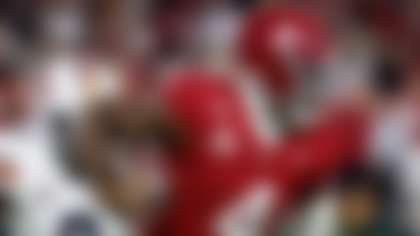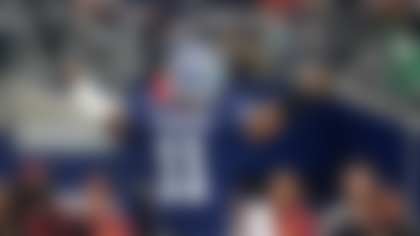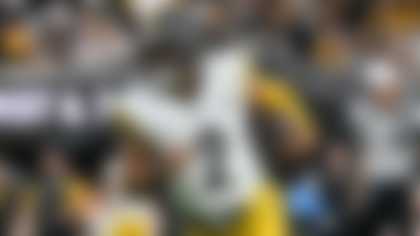Former NFL player and scout Bucky Brooks knows the ins and outs of this league, providing keen insight in his notebook. The topics of this edition include:
-- The problem with Jon Gruden's Raiders going all in on the draft.
-- Why the Cowboys' trade for Amari Cooper should be applauded.
-- A remedy for Philadelphia's slow start.
But first, a look at how one of the more disappointing teams of this season can turn it around ...
* * * **
"There's no such thing as an automatic next step."
The words of my former defensive coordinator in Green Bay, Fritz Shurmur, certainly apply to the current woes of the Jacksonville Jaguars. The AFC runner-ups were expected to build on their breakthrough 2017 campaign and make a spirited run at Super Bowl LIII, but the Jags (3-4) are quickly discovering the NFL doesn't care about your previous successes.
That's the lesson Shurmur drilled into his 1996 Packers defense during our first team meeting of the offseason, after we had finished one step short of Super Bowl XXX with a loss at Dallas in the '95 NFC Championship Game. The grizzled coaching veteran stood in the front of the room and told us that we had to earn our way into the playoffs again by going through the process all over, and that we couldn't take any shortcuts along the way. From re-mastering the playbook, to going through the basic run fits in each and every defensive front, to running to the ball in a series of high school-like pursuit drills, we all understood the clear message from Shurmur: The process starts over at square one.
When I look at these Jaguars, it appears they believed they could fast-forward through the regular season and automatically start the 2018 campaign in the AFC Championship Game. The players provided a bunch of offseason banter, boasting about their status as Super Bowl contenders. But nearly two months into the season, that's far from the case. Heading into this Sunday's London showdown with the defending Super Bowl champion Eagles (a team that's off to a disappointing 3-4 start of its own), Jacksonville is mired in a three-game losing streak.
Jaguars head coach Doug Marrone has previously discussed the need to get back to basics.
"Fundamentally, we have gotten away from some things and that is on us as coaches," Marrone told reporters, via ESPN, prior to the team's 20-7 home loss to the Texans last Sunday. "What I have challenged the coaches and I challenged myself with this week is, 'Hey, listen -- we have to get back to fundamentals. We have to stick with something that we can sink our teeth in and this way we can go out there and just perform.'
"This may just be my philosophy that any time you see football being played as poorly as we have been playing, then that is what it comes down to (fundamentals). That is my philosophy. You guys may differ, but you have to do things well fundamentally. Usually, when you do that, you have a chance to play better."
Although the Jaguars faltered in that game, I'm in lockstep with Marrone's sentiments: recommitting to the fundamentals is the only way Jacksonville can get back to being the feared team that emerged as a rising AFC bully last season.
"There is no magic pill or magic moment that you can just snap your fingers and go," Marrone said. "The only way to start playing better is you have to work your ass off. You have to work hard. You have to go back there. You have to coach better. We have to play better. I have to do a better job. That is how simple it is."
It really is that simple for the Jaguars. Just watch the tape. The team is certainly talented enough to make it to the title game, but Jacksonville must re-establish its identity on both sides of the ball. I watched the All-22 Coaches Film of the Jags' last few games. Here are three suggestions that I scribbled in my notebook:
1) Run, run, run. It is easy to beat up on Blake Bortles for his accuracy issues and turnover woes, but No. 5 is what he is at this stage of his career -- and that's a game manager-type quarterback with enough athleticism and mobility to create some plays outside of the pocket. Bortles is at his best when working off play-action on early downs with a designated checkdown to target if the deep shot isn't available.
With that in mind, the Jaguars have to be stubborn when it comes to the running game. The team needs to set a goal of 35 rushing attempts each week and grind it out with T.J. Yeldon, Carlos Hyde and, when he returns, Leonard Fournette. Last season, when Marrone was talking about how his ideal game plan would include "zero" passing attempts, the Jaguars led the NFL in rushing yards (141.4) and rushing attempts (32.9) per game. In 2018, though, the Jaguars are averaging fewer than 100 rushing yards (98.6) on just 23.1 attempts per game. That certainly doesn't work in the much-maligned quarterback's favor. Bortles needs to be on a strict pitch count that tops out at 30 passes, but fewer rushing attempts obviously means more throws. If the Jaguars want to reduce their turnover woes, they have to give the ball to the running backs and rely less on Bortles to create splash plays in the passing game. It's not sexy, but it has worked for the Jags in the past -- and it will work again if they commit to jamming the ball down their opponents' throats.
That's why the move for Hyde was a big one for Jacksonville. The 6-foot, 229-pounder is a bowling ball between the tackles, bringing a rugged running style that works well in the Jaguars' power-based system. With Fournette currently sidelined by a nagging hamstring injury, Hyde's arrival gives the Jaguars an RB1 to lean on until No. 27 returns to the lineup. And the combination of Hyde and Fournette together is quite enticing. Each runner excels between the tackles, but flashes enough explosiveness to take it to the house from distance. If the Jaguars can get their dynamic duo 15-20 touches a piece, they can control the game and force opponents to play "bully ball" in the fourth quarter.
2) It's all about the ball. Every coach discusses the importance of the turnover battle, but the Jaguars' giveaways are torpedoing their chances this season. Jacksonville currently ranks 31st with a minus-12 turnover differential, as the offense has committed 17 giveaways while the defense has logged just five takeaways. Last season, the Jags finished with a plus-10 turnover differential (tied for fifth) on the strength of 33 takeaways from the defense.
Obviously, Bortles needs to curb his turnovers (eight interceptions, three fumbles lost), but the rest of the team also needs to focus on securing the football at all times. Defensively, the Jaguars have to force opponents into more predictive situations to allow the pass rushers and ballhawks to hunt. If opposing quarterbacks are forced to throw in more long-yardage situations, the defensive line will be able to aggressively rush the passer while defensive backs can squat on routes at the sticks to pick off passes.
The Jaguars are pretty hard to beat when they're playing clean football on both sides of the ball. We just haven't seen that in 2018.
3) Hit, run and cover. Those three words are echoed on practice fields all over the league, but no unit embodies the simplicity of that statement more than the Jaguars' defense -- at least when it's firing on all cylinders. The unit features a number of ultra-athletic playmakers with the kind of speed, explosiveness and nasty temperament that every coach covets in elite defenders. When the Jaguars are playing sound football and adhering to the principles of their simplistic scheme, they make life miserable on opposing offenses.
This season, the Jaguars haven't played their best ball, but they still rank second in total defense (301.6 ypg) and sit among the top 10 in most major defensive categories. Better than you thought, huh? That's why you shouldn't count out Jacksonville's D despite a widespread narrative suggesting the bodacious unit has lost its swagger. Sure, the Jaguars have been outscored a combined 57-0 in the first halves of their last three games, but a lot of those points were the result of the offense giving the ball way deep in Jacksonville's own territory. If the offense can do a better job of securing the ball, the Jaguars' D is still capable of winning games with little assistance.
If I had to cite a concern regarding the Jaguars' defense, I would point to a slippage in coverage. Jalen Ramsey and A.J. Bouye have allowed a 60 percent completion rate, 6.8 yards per attempt and an 85.1 passer rating in 2018. That's after holding opponents to figures of 48.3, 5.8 and 48.5 in those same stats a year ago. Opposing QBs are also targeting the Jaguars' slot corners (D.J. Hayden and Tyler Patmon) with alarming success. The duo is allowing scary numbers in completion rate (81.5), yards per attempt (7.6) and passer rating (110.8) on throws in their direction. Last season's primary slot cover man, Aaron Colvin, held foes to 72.6, 5.1 and 83.9 in those areas.
Part of Jacksonville's issues could stem from the team's increasing reliance on quarters coverage. The Jaguars are employing this scheme at the highest rate of any team in the league, with a 23 percent usage rate (up from 16.3 percent in 2017). This season, quarterbacks are completing 67.4 percent of their passes against the coverage, at a rate of 7.3 yards per attempt and with a 79.3 passer rating. Last year's numbers in quarters coverage: 59.5, 4.6 and 41.3 passer rating. Although those 2018 numbers aren't awful, Jacksonville should consider mixing up its coverage to keep opponents from using all of the quarters beaters that lead to easy completions and big plays on the perimeter. If the Jaguars mix in some more man coverage, with a few blitzes, they can disrupt the timing of the opposing quarterback and force some of the turnovers needed to get more checks in the win column.
RAIDERS' DRAFT CAPITAL: Can Gruden really deliver the prospect goods?
Following the Amari Cooper trade, the Oakland Raiders now have three first-round picks in 2019 -- and five over the next two seasons. Still, I'm not convinced Jon Gruden can parlay these lottery tickets into a handful of blue-chip players based on his draft history. Although I saw first-hand how the one-time Super Bowl champion build a title contender in Oakland during the 1990s, I remain skeptical of him as the latest football czar attempting to buck the odds by winning the draft. Considering the team traded away a pair of players with Pro Bowl accolades on the resume (Khalil Mack and Amari Cooper), Gruden would need to select at least two all-star talents to get comparable value for what walked out of the door in Oakland.
To be fair, the Raiders selected Mack and Cooper with top-five picks, which indicated they were widely viewed as transcendent players with the potential to rank among the top five at their respective positions in the NFL. Based on pro production, you could definitely make that case for Mack, but Cooper has probably ranked somewhere in the 10-20 range at receiver during his best seasons. Regardless, Oakland dealt two talented players.
On paper, Oakland certainly has enough draft currency to collect some top-notch players. Those five first-round selections comprise more than enough ammunition to move up the board to select a generational talent at No. 1 overall, if necessary. The team could also stand pat and add a bevy of enticing prospects. In a perfect world, all of those first-rounders would become high-level starters and core players for a team rebuilding from the ground up.
"Every team builder would love to have a bunch of top picks to rebuild the roster," an AFC college scouting director told me. "If you hit home runs with those picks, you can quickly turn it around. ... You just need to make sure that you don't strike out. If you don't land high-level starters in Round 1, it sets your franchise back.
"You have to get it right when you have that many picks at the top of the draft."
Here's the problem: It's hard to consistently nail draft picks, particularly in the first round. The success rate in the first round is much closer to a coin flip than you might think. Here's what Falcons GM Thomas Dimitroff told Pro Football Talk a couple years back: "According to our most recent statistics that we drew on the first round, it's less than 60 percent of those players that are starting."
Oakland has certainly struggled with Round 1 in recent years. Of their last 13 first-round selections, the Raiders have only snagged two Pro Bowlers (Mack and Cooper) despite having several top-10 picks. Now, I know different people have been responsible for different picks, but still -- the draft history is ... rough. Guys like Robert Gallery (No. 2 in 2004), Fabian Washington (No. 23 in 2005), Michael Huff (No. 7 in 2006), JaMarcus Russell (No. 1 in 2007), Darren McFadden (No. 4 in 2008), Darrius Heyward-Bey (No. 7 in 2009), Rolando McClain (No. 8 in 2010), D.J. Hayden (No. 12 in 2013), Karl Joseph (No. 14 in 2016), Gareon Conley (No. 24 in 2017) and Kolton Miller (No. 15 in 2018) were selected ahead of some blue-chip players. Thus, it's not a given the Raiders will knock it out of the park with their five first-round selections over the next two years. In fact, their odds of landing multiple Pro Bowl players in the 2019 first round -- when the Silver and Black possess three picks -- amounts to another coin flip, based on statistical history.
In the common draft era (since 1967), 13 teams have picked three-plus players in the first round, including the Cleveland Browns in 2017. If we exclude the Browns -- since it's still early to truly judge those selections -- 75 percent of those teams (9 of 12) drafted at least one Pro Bowler, and 58.3 percent of those teams (7 of 12) drafted two Pro Bowlers. However, only five teams (41.6) drafted players with multiplePro Bowl nods (like Mack and Cooper). And zero teams drafted three-plus Pro Bowlers with their selections, while three teams didn't come away with a single Pro Bowl bid. Take a look:
Note: Pro Bowl nods listed parenthetically.
2017 Cleveland Browns (3 picks):David Njoku (0), Jabrill Peppers (0) and Myles Garrett (0).
2013 Minnesota Vikings (3 picks):Cordarrelle Patterson (2), Sharrif Floyd (0) and Xavier Rhodes (2).
2001 St. Louis Rams (3 picks): Adam Archuleta (0), Damione Lewis (0) and Ryan Pickett (0).
2000 New York Jets (4 picks): Anthony Becht (0), Chad Pennington (0), John Abraham (5) and Shaun Ellis (2).
1995 Carolina Panthers (3 picks): Blake Brockermeyer (0), Kerry Collins (2) and Tyrone Poole (0).
1991 Dallas Cowboys (3 picks): Alvin Harper (0), Kelvin Pritchett (0) and Russell Maryland (1).
1988 Los Angeles Raiders (3 picks): Scott Davis (0), Terry McDaniel (5) and Tim Brown (9).
1984 Cincinnati Bengals (3 picks): Brian Blados (0), Pete Koch (0) and Ricky Hunley (0).
1983 San Diego Chargers (3 picks): Billy Ray Smith (0), Gary Anderson (4) and Gill Byrd (2).
1977 Cincinnati Bengals (3 picks): Eddie Edwards (0), Mike Cobb (0) and Wilson Whitley (0).
1976 New England Patriots (3 picks): Mike Haynes (9), Pete Brock (0) and Tim Fox (1).
1975 Los Angeles Rams (3 picks): Dennis Harrah (6), Doug France (2) and Mike Fanning (0).
1973 New England Patriots (3 picks): Darryl Stingley (0), John Hannah (9) and Sam Cunningham (1).
Looking at the Raiders' situation, it is important to evaluate the football czar making the selections to get a feel for whether the team can parlay the picks into blue-chip players. Although Reggie McKenzie holds the general manager title, let's be honest: Gruden will have a STRONG say on the picks. And that doesn't necessarily bode well for Raider Nation. The head coach had a checkered draft history in Tampa Bay (where he also had a big say in personnel matters), as evidenced by the Bucs' selections of Michael Clayton (No. 15 in 2004), Carnell "Cadillac" Williams (No. 5 in 2005), Davin Joseph (No. 23 in 2006), Gaines Adams (No. 4 in 2007) and Aqib Talib (No. 20 in 2008). Sure, Joseph and Talib developed into Pro Bowlers, but Clayton and Williams flamed out quickly after stellar rookie seasons. Adams failed to make an impact as a top pick. (And in 2010, Adams tragically died from a previously undetected heart condition.)
All of that displays why it's not going to be easy for the Raiders to swiftly turn things around after tossing away talent for lottery tickets. While it looks good on paper to have a fistful of draft picks at the top of the board, history suggests Gruden will be lucky to break even.
THREE AND OUT: Quick takes on big developments across the league
1) The Cowboys get their man. It's hard to admit you're wrong in this business, which is why I tip my cap to Jerry Jones and the Dallas Cowboys for acquiring Amari Cooper to fill the team's void at WR1. Despite their bold proclamations suggesting the team didn't need a No. 1 receiver, the personnel department and coaching staff, in effect, finally admitted they misevaluated the talent on the outside when they coughed up a first-round pick to snag the two-time Pro Bowler.
Now, I'll admit to drinking the blue Kool-Aid when I suggested Dak Prescott would do some Tom Brady-like things with his previous crew. But it didn't materialize over the first seven weeks of the season. The 2016 Offensive Rookie of the Year is averaging just 202.4 passing yards per game while completing 62 percent of his throws with an 8:4 touchdown-to-interception ratio and an 87.4 passer rating.
In a league with 10 quarterbacks averaging at least 300 passing yards per game and 10 signal-callers posting a passer rating of 100.0 or better, Prescott's numbers are well off the marks posted by "franchise" guys around the league. That's why the Cowboys owed it to their QB1 to get him a WR1 to help him reach his potential as a starter. Most importantly, they owed it to themselves to surround their star quarterback with enough talent to make a solid assessment of his talent and long-term potential.
With the possibility of a $100 million payday on the horizon, the Cowboys want to see where Prescott stands in the NFL quarterback pantheon before writing the check. That makes sense, right?
On the field, the addition of Cooper gives the Cowboys a legitimate playmaker on the outside. He's an outstanding route runner with excellent stop-start quickness and body control. Cooper is also a spectacular double-move specialist with the potential to slay defensive backs with a variety of routes, particularly slants, "sluggos"(slant-and-go), hitches, hitch-and-go routes, digs and outs.
Against "off" coverage, Cooper is more than capable of winning his one-on-one matchups vs. man or zone. Now, he has struggled with the dropsies over the past two seasons but certainly has put enough splash plays on tape over the last three-plus years to suggest he can make an impact as a lead receiver, particularly when he is able to play with an RB1 who commands enough attention to create one-on-one chances on the outside.
"He's a talented player," an AFC college scouting director told me. "I thought he was pretty special when he came out a few years ago and still believe he can be an elite player. I know his production has fallen a bit, but he has the kind of skills that everyone looks for in a No. 1 receiver."
Cooper's skills are an ideal fit for a Dallas offense that desperately needed an outside playmaker with the capacity to win consistently outside the numbers. With opponents throwing out eight-man fronts to slow down Ezekiel Elliott, Cooper could get 8-10 targets on isolation routes (hitches, slants, curls and comebacks) from run-heavy formations.
In spread formations, Cooper could be a valuable asset to the passing game, particularly when Dallas pairs him with Cole Beasley on one side of the field. No. 11 works the middle of the field as well as anyone in football, which makes Cooper even more dangerous on combination routes between the numbers.
Considering how bad the Cowboys' passing game looked without a real WR1 on the field, the addition of Cooper fills a need and gives them a chance to make a fair evaluation of their franchise quarterback.
2) Nothing wrong with Hue Jackson exercising his right as HC. I know Hue Jackson has become a bit of a punching bag due to his 3-35-1 record over the last two-plus years, but the Cleveland Browns' head coach wasn't out of line when he expressed a desire to "help" coordinator Todd Haley fix the team's offense.
"I feel like I have to and I want to," Jackson told reporters after the Browns' Week 7 loss to the Bucs. "That's what I know, so I'm not going to continue to watch something that I know how to do keep being that way, and that's just the truth. I mean, that's nothing against anybody in our building. I just think that's what I do and I think I need to be a little bit more involved."
What's wrong with that? Why would any head coach sit on the sideline and watch his former unit struggle when he has experience and a solid track record of success as a play-caller?
We've seen coaches like Mike McCarthy and Sean McDermott take over play-calling duties when they didn't like the way their units were performing. We've also watched Andy Reid put his stamp on his offense despite having his offensive coordinator (Eric Bieniemy) serve as the primary play-caller.
That's why I'm not surprised to hear Jackson voice his desire to become more involved with the offense with the unit stumbling out of the gate to start most games. Former play-callers, particularly successful ones (see: Jackson's work in Cincinnati and Oakland), always believe they know how to jump-start a sagging offense. Whether it's through scheming or personnel deployment, top play-callers believe they can come up with the answers to solve the unit's struggles.
"Trust me, I'm not trying to create any issue here," Jackson said. "But I think if the offense is not playing well and we haven't over a period of time, being a head coach and an offensive guy who's done this, I think I have every right as a head coach to jump in here and see if I can help, and assist, and get this thing to where I think it needs to because we need to be better on offense. And if that's my specialty, then I need to be involved more and I will be."
Jackson is right. As the head coach, he has every right to jump in and tell his assistants what he wants. He is responsible for setting the vision for the team and his assistants are expected to follow his lead. Thus, Jackson retains veto power over his coordinator's play-calls and he has the authority to suggest or mandate play-calls at his own discretion.
Now, I know Haley is well-respected as a coach and play-caller in the league, but he still must defer to Jackson based on the Browns' coaching hierarchy. In addition, the head coach and offensive coordinator should engage in steady dialogue throughout the week and game to exchange ideas on how to best attack the opponent. Moreover, the head coach will tell the offensive coordinator how he wants the game played and when to ramp up or dial back the tempo to put the team in the best situation to win.
When I broached the head coach-coordinator relationship with two-time Super Bowl champion head coach Jimmy Johnson in the spring, he told me the head coach should regularly offer his input and even suggest plays early in games to set the tone. Johnson told me that it was important for the coach to make suggestions early to avoid rubbing the coach the wrong way with a late-game suggestion. In addition, Johnson discussed the importance of setting the vision for the week and holding his coaches accountable when implementing the plan.
Considering the uncertainty surrounding Jackson's job beyond 2018, I'm not surprised the Browns' head coach is being a little more proactive addressing issues that could ultimately lead to his dismissal.
3) Cure to what ails Eagles is on the ground. The NFL is definitely a passing league, but the defending world champions are finding out that it's hard to win consistently without a running game. The Eagles have stumbled out of the gate to a 3-4 start, partially due to the team's inability to run the ball. After fielding the league's third-ranked rushing attack (132.2 rushing yards on 29.6 carries per game) in 2017, the Eagles currently rank 21st in the league with an average of 102.9 yards on about four fewer carries (25.7) this season.
While I certainly understand Doug Pederson's desire to put the ball in the hands of his team's best player (Carson Wentz), the Eagles are at their best when they rely on a balanced attack. Look no further than the team's 3-0 record with 25 or more rushing attempts and their 0-4 mark with fewer than 25 rushing attempts as proof of the running game's importance.
That's why I'm a little surprised the team has been so pass-heavy since the return of Wentz in Week 3, particularly with the star quarterback coming off a torn ACL that prematurely ended his MVP-caliber campaign a season ago. Since returning to the starting lineup, Wentz is averaging 39 passes per game and the team is averaging 25.8 rushing attempts. Although No. 11 has been sensational, posting a 70.8 percent completion rate with a 10:1 touchdown-to-interception ratio and a 108.1 passer rating in five starts, the Eagles are 2-3 since he returned to the lineup and each of his three 300-yard passing games has resulted in losses.
Now, I know the NFL is a quarterback-driven league with the elite QB1s expected to put up big numbers on a weekly basis, but the Eagles' winning formula requires a more balanced offensive approach. Last season, the team leaned on Jay Ajayi and LeGarrette Blount to anchor an "RBBC" (running back by committee) approach that quietly sparked the team's run to the title. The big-bodied running backs thrived on quick-hitting runs between the tackles, exhibiting a collective combination of power, physicality and toughness that helped Philly grind out close wins.
With Ajayi (ACL) on injured reserve and Blount now playing in Detroit, it is fair to wonder if Pederson has legit trust in RBs Wendell Smallwood and Corey Clement.
"It's not that I lose confidence in the run game," Pederson explained after the Eagles' Week 7 loss to the Carolina Panthers. "It's not that at all. I got a lot of confidence in the run game. We all have confidence in that O-line room. Those guys are good, really good, and they're talented and the (running) backs are talented.
"It's still an aggressive mentality when I run, and it's still an aggressive mentality when I throw. It's always going to maintain that. We're always going to maintain that aggressiveness. I have no lack of confidence whatsoever in our run game."
If that's true, Pederson must get back to the ground-and-pound attack that helped balance out Philadelphia's high-flying offense a season ago. With Smallwood and Clement in the backfield, the Eagles can't necessarily rely on the power-based running game that propelled them to a title last season, but they can use more deception and misdirection to take advantage of the current backs' quickness and burst. The duo has combined for 394 rushing yards on 98 attempts. and their 4.0-yard average is respectable enough to warrant more carries. But Pederson has to display enough patience to live through some minimal gains in order to reap the rewards in the game's late stages.
"You throw to score, but you have to run to win," a former NFL defensive coordinator told me. "The running game allows you to control the game and set the terms. If you can run it, the defense is at your mercy. ... Most offensive coaches don't have the patience and discipline to stick with it, though."
If Pederson wants to get the Eagles back into the tournament to defend their title, he has to rely less on Wentz's right arm and commit to sticking the ball in the bellies of his young running backs over and over again.
Follow Bucky Brooks on Twitter @BuckyBrooks.












